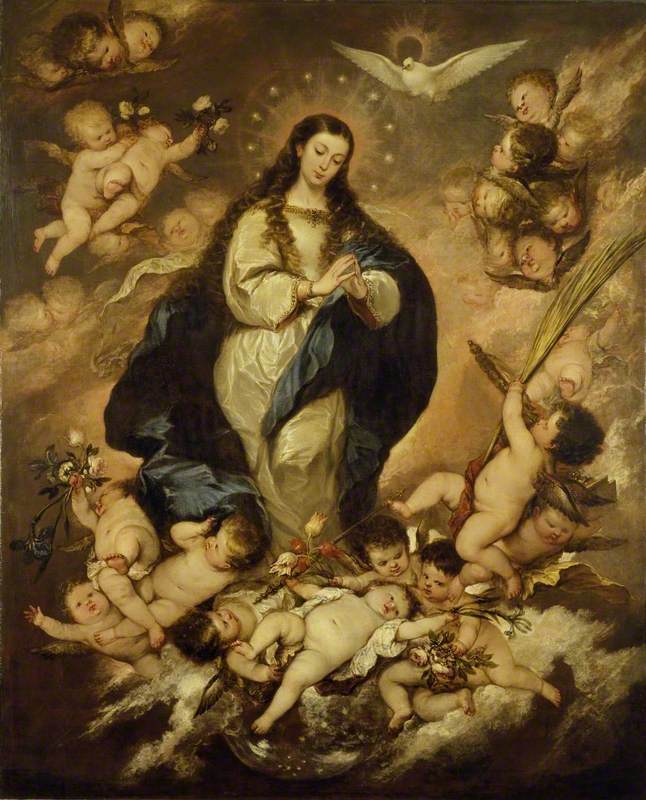The Church celebrates the Immaculate Conception of Our Lady today. This evening there was a splendid Sung Mass at the Oxford Oratory to mark the Feast. It is always a high point in the liturgical year as the Immaculate Conception is patron of both the Oratory and of the Archdiocese of Birmingham.
The Immaculate Conception
Jose Antolinez (1635-75)
Painted 1668-70
The Bowes Museum
Image: Bowes Museum / Wikimedia
I have posted before about this painting on this feast and I make no apologies for doing so again. My previous post from 2014 can be seen at The Immaculate Conception of Our Lady
Antolinez was working when the subject was very popular in Spain. Although not given dogmatic definition until 1854 by the great and good Pope Pius IX in 1616 King Felipe III had created the Real Junta de la Immaculada and proclaimed the Spanish Crown as the greatest defender of the doctrine. This led to a propaganda campaign in favour of the doctrine across the Spanish realms to Italy and New Spain and one which used fine art to promote it. Indeed it has been described as “one of the most striking campaigns of visual propaganda in history.” The patronage of the monarchy included the foundation of the royal chivalric Order of King Carlos III by that monarch, with its badge depicting the Immaculate Conception and its riband using the distinctive Marian blue. It was that King’s great granddaughter Queen Isabella II who secured from Pope Pius IX the Spanish privilege of wearing blue vestments on Marian feasts as recognition of the part the Church in Spain had played in establishing the truth of the doctrine of the Immaculate Conception.
The painting itself is one that impressed itself on one’s mind and memory. In the wonderful and rich collection of European decorative art at the Bowes Museum it repays the climb to the top floor where it dominates one wall of the gallery of Spanish art - the largest such collection of Iberian old masters in this country outside London. Its combination of grandeur and charm, of majesty and delicacy, above all of exuberant joy makes an immediate impact. That is to appreciate the skill of the artist, but it is also a spiritual experience. The use of flowers emblematic of the Virgin - lilies, roses, irises - and other symbols of purity and Marian regality is delightful. I saw it several times when I lived in the north and I recall a lady I knew in my home town who was waxing eloquent about a painting she had seen at the Bowes and I guessed immediately which one it was. In my opinion it surpasses many other such depictions of the Immaculate Conception by artists of the era.
Jose Claudio Antolinez ( 1635-75 ) spent most of his painting career working in his home city of Madrid. He frequently painted the Immaculate Conception, done in a colourful and gentle style, yet also possessing that joyful and exuberant sense. In contrast Antolinez himself was known for having a bad temper and a considerable ego. His “ haughty character and sarcastic personality gained him many enemies among his contemporaries “. and he played maddening jokes on his colleagues. In addition to his religious paintings he also produced several portraits and genre scenes. He died in Madrid from a fever in 1675 when he was some months short of his fortieth birthday after suffering a number of wounds during a fencing match. There is more about his works at José Antolínez
I find that there is another version of the painting and contemporaneous in date in the Ashmolean Museum here in Oxford which was purchased in 1941.
The version of the same composition by Antolinez in the Ashmolean Museum in Oxford
Image: Ashmolean Museum
It is an inevitable regret that these two versions do not hang in a church for appropriate veneration and reflection, but an art gallery can still provide a reasonably suitable environment for such things.
I do not recall having seen the Oxford copy on my visits to the Ashmolean. The Bowes Museum version is, as I hope I have indicated above, along with the rest of their collection very well worth seeing, and well worth the drive to Barnard Castle, whether to test ones eyesight or not....
May the Immaculate Heart of Mary Pray for us




No comments:
Post a Comment